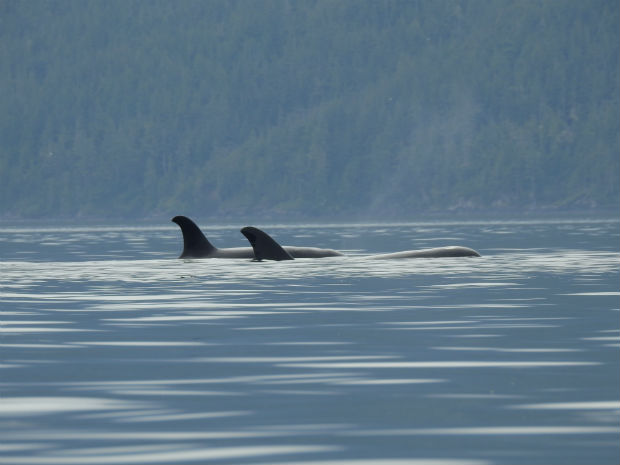
“A paddle held straight up in the air, means come to me and stop. A paddle pointing in any direction overhead, means we are turning that way. And ‘jazz hands’ (shaken antler-high) means, ‘Shhh… Wildlife ahead!’ “
Those were our guide’s final instructions in a series of briefings that would prepare us for our 4-day kayak/camping adventure from Vancouver Island’s picturesque northeast coast.
“Jazz hands” may not be the official international signal for “wildlife ahead!” but for anyone who’s kayaked British Columbia’s stunning Johnstone Strait with ROW Adventures, a lead kayak making-like-an-elk usually means they’ve spotted a pod of orcas, humpback whales, porpoises, seals, otters or an eagle. Oh, and maybe a bear too.
Our early morning arrival into Telegraph Cove felt eerily similar to rolling into Gansbaai, South Africa. Both are idyllic, sleepy little bays, and oceanic Meccas made famous as gateways to encounters with two of the oceans’ apex predators, the Great White Shark in Gansbaai, and the enigmatic Orcas off Telegraph Cove.
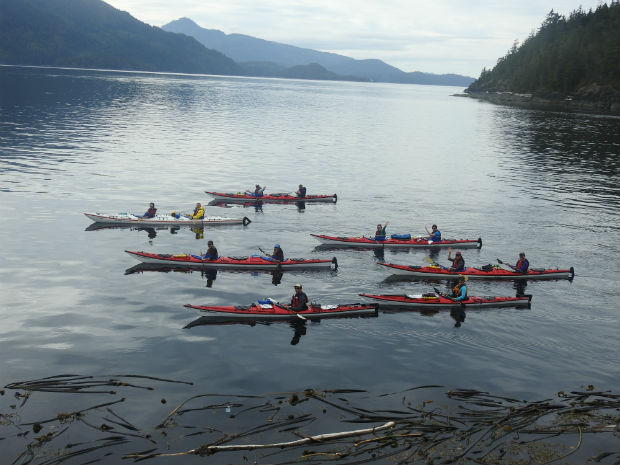
Relaxed and organized, our flotilla of 14 paddlers quietly headed out, divided into a pair of single sea kayaks and six doubles. Almost immediately, we were met by the unpredictable weather patterns the area is also known for. Steady headwinds picked up as we exited the cove eastbound, driving late-summer rain straight into our faces. Soaked and knowing we couldn’t get much wetter, the weather became irrelevant.
After a 4-hour day on the water, broken up by a soggy shore lunch, we arrived at our camp and hauled our vessels up the beach. We broke into pairs and claimed our waiting tents – each fixed off the ground on a sturdy wooden structure, appointed with two proper cots, Therm-a-Rest mattresses, sleeping bags, pillows and a table, with enough height for a six-footer to stand up straight. Even with these relative luxuries, the camp’s setting was authentic.
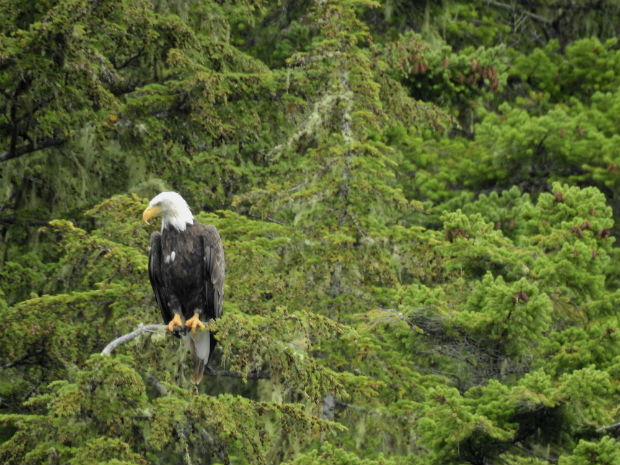
Leased from the ‘Namgis First Nation, a strict Leave No Trace policy keeps the pristine surroundings unspoiled. There is no septic toilet system or electricity. Toilet paper is burned in a can and meals are prepared on propane powered mini-stoves. All garbage is brought back at the end of a stay, and on a clear night, the moon and the stars are blinding. After a satisfying dinner prepared by our stellar guides (more on this later), some boxed red wine and a surprise guitar sing-a-long, we readily shut it down.
On our first full-day out from camp opposite Hanson Island, the weather was perfect and the Orcas were plentiful, or at least easier to spot. An 8-foot tall, pitch-black dorsal fin slicing through the glassy surface of a resting sea is as obvious as the balls on a dog, and in that stillness, an orchestra of trading blowholes, unmistakable.
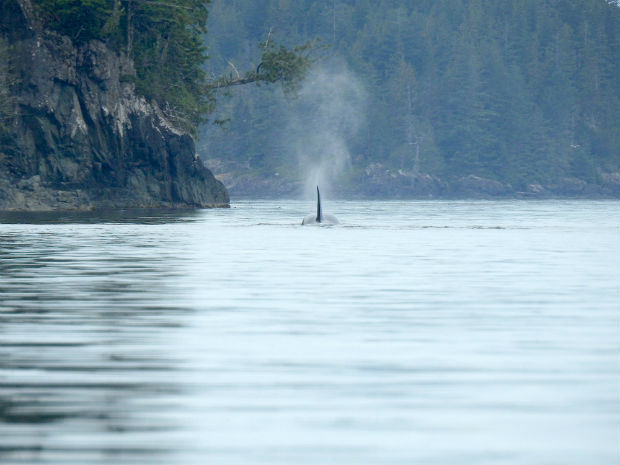
We spent the day awestruck, surrounded by multiple pods of Resident Orcas chasing schools of salmon about to run, jazz hands everywhere. We also spotted seals, the dogs of the sea and solitary swimmers here. Dall porpoise sightings almost became routine. Our 4-hours out, broken up by a sunny shore lunch this time, flew by and we reluctantly returned to camp.
Okay, picture this: a perfectly-layered, hearty, ooey-gooey, melt-in-your-mouth lasagna, magically made stove-top, in a big, deep soup pot. Yup. Our guides were on point, and as solid as this recipe that blew us all away – until the divine Eggs Benedict (with a flawless Hollandaise sauce!) for breakfast the next day.
Crossing the Strait over to Hanson Island was a 40-minute, steady-stroke paddle, at times challenging due to a strong tangle of currents. To steady ourselves on the windward edge, we paddled directly into a mess of bull kelp and parallel parked in their heavy, thick sea branches. We watched and waited, bobbing in the kelp, sharing Trail-mix.
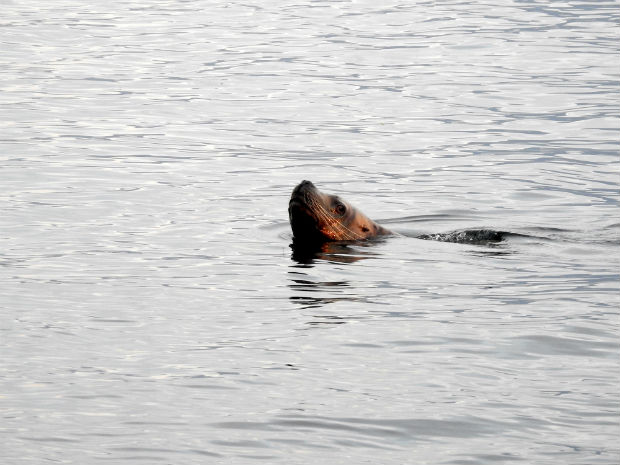
Later that night, we learned of captivating native ‘Blackfish’ legends, the atrocities of their capture for marine parks and about the species in general. How there are three different types of the whale; the Resident (salmon eaters, comprised of Northern and Southern Residents, separated by Campbell River), the mammal-eating Transient pods, nomadic with a wider range, and the Oceanic, or Offshore Orcas, found in the open sea praying on everything – fish, sharks and whales.
Orca families, or pods, are matrilineal in structure, with offspring that instinctually mate outside of the pod to deepen the gene pool, with only the males returning to the pod after mating. Orcas exhibit a complex social system where each pod has its own accent of the same language. What`s more, Resident Orcas speak a different language than the Transients do. And Oceanic Orcas have an entirely different language altogether.
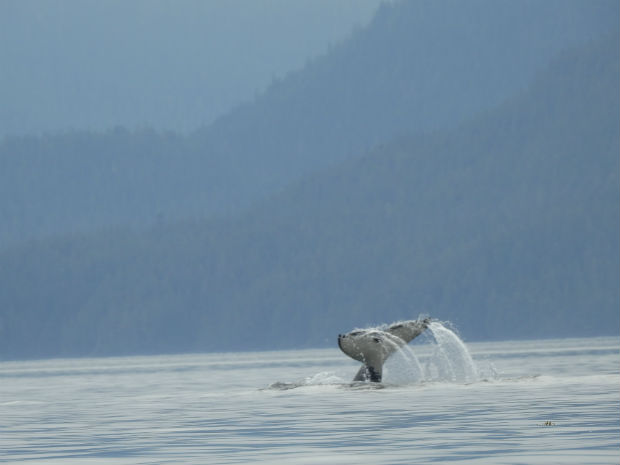
Watching these majestic creatures in the waters they’ve inhabited for over 11 million years, just being whales, being a family, so similar to us, was exhilarating, humbling and unforgettable. It was also sad. With the amount of them that we had the pleasure of sharing the sea with, I was shocked to learn that there are fewer than 300 Northern Resident Orcas left, with even less of their Southern counterparts, landing them on the Endangered Species List.
I realized how lucky I was to have witnessed what I did. And seeing it all from a non-intrusive, man-propelled, non-polluting private vessel made it that much more.
Reading as I write this, a young Southern Resident Orca was found dead off the BC coast, possibly due to malnutrition. Wild Pacific salmon, the Resident Orca`s main food source, have had a tough year, which means that Orcas have too. With pipelines planned to bring bitumen and around 700 oil tankers annually into sensitive Orca habitat, things aren’t looking any better. If you’d like to experience these magnificent beings before it’s too late, go now.